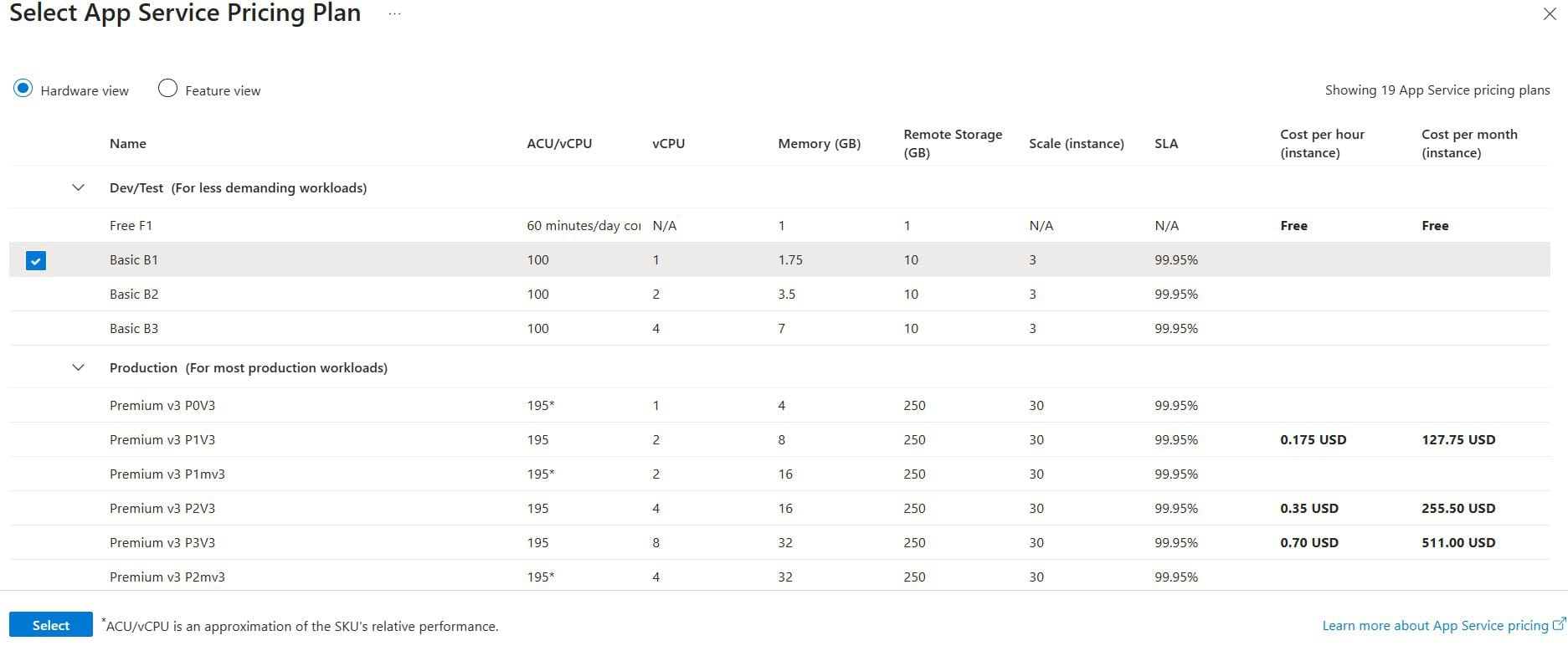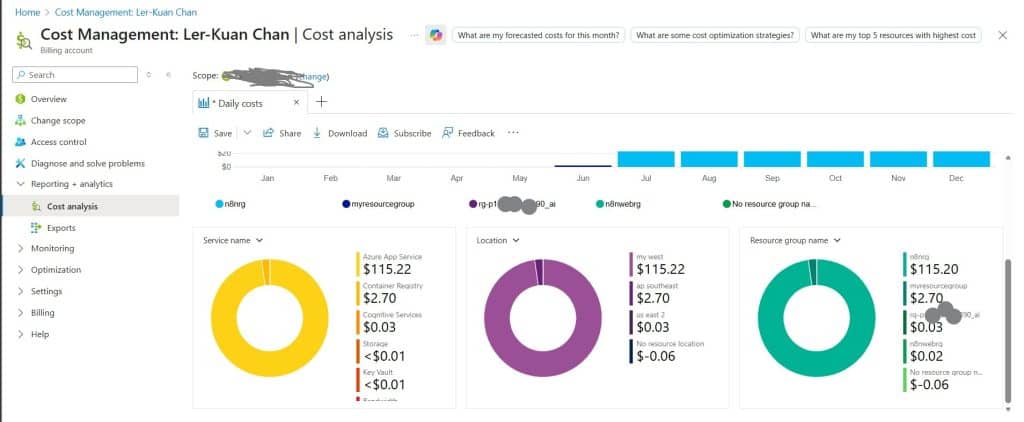Step-by-Step Guide to Hosting n8n on Azure
🚀 How I Deployed n8n on Azure Using Docker: A Step-by-Step Guide
As a fan of automation and low-code tools, I’ve been exploring n8n, an open-source workflow automation platform that’s incredibly powerful and flexible. Recently, I decided to host n8n on Microsoft Azure using a Docker container—and I’m sharing the process here to help fellow developers and tech enthusiasts do the same.
🧭 Why Azure + Docker?
Azure App Service offers a clean and scalable way to deploy containerized applications. By using Docker, I get full control over the environment and dependencies, while Azure handles the infrastructure, scaling, and security.
🛠️ Step-by-Step: Hosting n8n on Azure Web App (Container)
Step 1: Create a Web App on Azure
Start by logging into the Azure Portal and creating a new Web App:
- Choose:
- Subscription and Resource Group
- Name: e.g.,
n8n-container-app - Publish: Docker Container
- Operating System: Linux
- Region: Select your preferred region
This sets up the foundation for your containerized deployment.
Step 2: Configure Docker Container Settings
In the Docker tab of the Web App setup:
- Image Source:
https://docker.n8n.io - Image and Tag:
n8nio/n8n - Leave the startup command blank unless you have custom needs.
This tells Azure to pull the official n8n image from Docker Hub.
Step 3: Set Environment Variables
Stop App services.
To secure and configure your n8n instance, head to:
Web App > Configuration > Application Settings, and add:
| Name | Value |
|---|---|
WEBSITES_ENABLE_APP_SERVICE_STORAGE |
true |
GENERIC_TIMEZONE |
yourTimeZone |
N8N_PROTOCOL |
https |
WEBHOOK_URL |
https://<your-app-name>.azurewebsites.net |
N8N_HOST |
<your-app-name>.azurewebsites.net |
N8N_PORT |
5678 |
Step 4: Restart and Launch
Once everything is configured:
- Restart the Web App from the Azure Portal
- Visit your app’s URL:
https://<your-app-name>.azurewebsites.net - Log in using the credentials you set
You should now see the sleek n8n workflow editor, ready to automate your world!
🧩 Final Thoughts
Deploying n8n on Azure using Docker is surprisingly smooth once you get the hang of it. This setup gives you the flexibility of containers with the scalability of Azure—perfect for building robust automation workflows.
Full Guide YouTube Link: https://youtu.be/lJrndpchAMo
A Big Credit to Muhamad Ali Ridho: https://www.youtube.com/watch?v=jFJXATuWvKI&ab_channel=MuhamadAliRidho%7CAI%26ngoprek
Cost Breakdown

In July 2025, I spent USD 54+ on hosting my web application using Azure’s Premium V3 P0V3 App Service plan. This month, due to budget constraints, I downgraded to the Basic B1 plan. While the cost savings are significant, the performance hit was immediately noticeable. Here’s a breakdown of the costs, specs, and lessons learned.
📅 July 2025: Premium V3 P0V3 Plan
- 💰 Cost: $0.175/hour → approx. $127.75/month
- ⚙️ Specs:
- 💪 ACU/vCPU: 195
- 🧠 Memory: 14 GB
- 🗄️ Remote Storage: 250 GB
- 📈 Scale: Up to 30 instances
- ✅ SLA: 99.95%
- 🚀 Experience: Smooth performance, fast response times, ideal for production workloads.
📉 August 2025: Basic B1 Plan
- 💸 Cost: Estimated under $20/month
- ⚙️ Specs:
- 💪 ACU/vCPU: 100
- 🧠 Memory: 1.75 GB
- 🗄️ Remote Storage: 10 GB
- 📉 Scale: Up to 3 instances
- ✅ SLA: 99.95%
- 🐢 Experience: Noticeably slower website performance, especially under moderate traffic.
🤔 Why the Downgrade?
With only $20 Azure credit left 💳, I had to make a tough decision. The Basic B1 plan seemed like a reasonable compromise, but the performance drop was more severe than expected 😓.
⏳ Cost Duration: How Long Can USD 20 Last on B1?
With only $20 Azure credit left 💳, I switched to the Basic B1 plan. Here’s how long it can sustain:
- Estimated B1 cost: $0.0133/hour
- Total hours covered: $20 ÷ $0.0133 ≈ 1,504 hours
- Total days: 1,504 ÷ 24 ≈ 62 days
🧮 Conclusion: Your $20 credit can run the Basic B1 plan for about 2 months, making it a budget-friendly option for low-traffic or test environments.
📚 Lessons Learned
- ⚡ Performance matters: Downgrading to save costs can impact user experience.
- 📊 Budget planning: Monitor Azure credits and usage to avoid last-minute downgrades.
- 🔍 Consider alternatives: Explore autoscaling, static site hosting, or hybrid architectures to optimize cost vs. performance.
🧠 Final Thoughts
If you’re running a production-grade app, the Premium V3 plans offer the reliability and speed you need 🏎️. The Basic B1 plan is suitable for dev/test environments 🧪 but may not meet the demands of live traffic 🌐.
Update 11 December 2025

I’ve reached the end of my Azure for Students credits and decided to delete the resource group. Looking back, I’m truly thankful for the opportunities it gave me to explore n8n and dive into AI automation—it was an invaluable learning journey.

Ler Travel Diary is using Web Hosting and n8n on Hostinger
To be a smart saver, check out ShopBack for more information.
Enjoy SGD5 discount voucher on Klook with code 53E7UD
Need discount for your travels? Check out our travel deals page.
